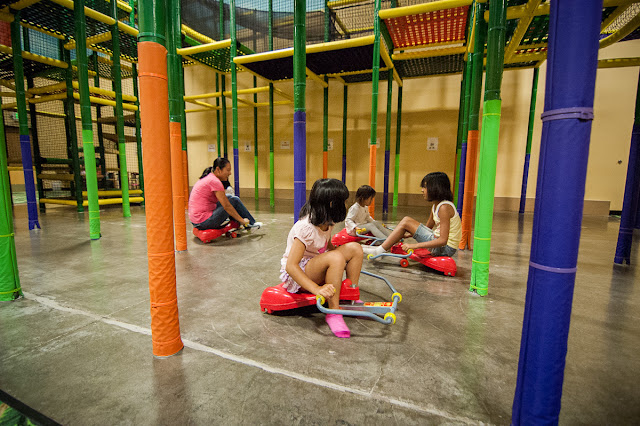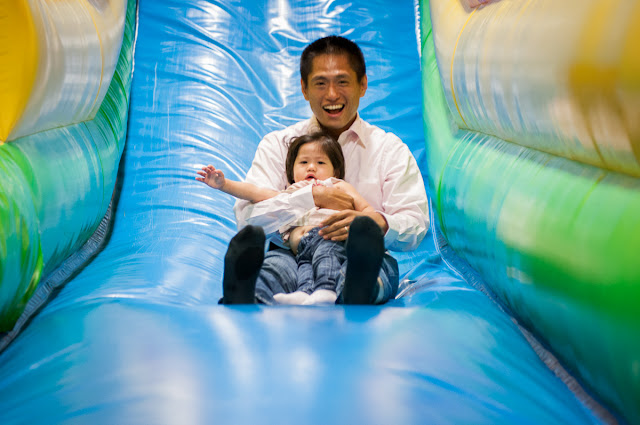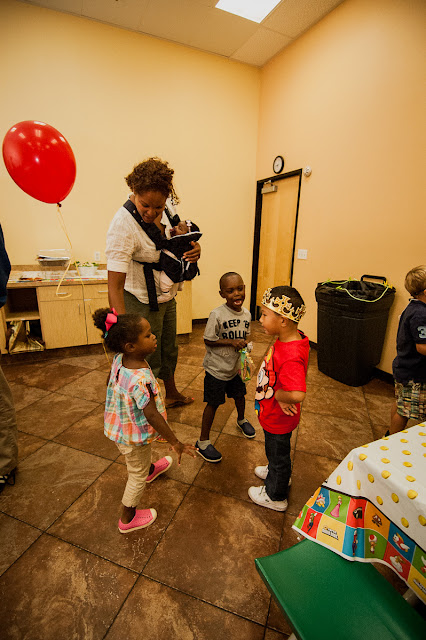We recently had a birthday party for our son. It was at a playhouse with large bounce houses and a play structure, with tall black ceilings (maybe about 30 feet high or so) and multicolored walls.

What lighting technique would you use in these circumstances? Hit the jump to see what approach I used.


When I'm indoors I prefer to use bounce flash because with proper technique, the light is soft and directional. In this situation however, I thought bouncing would be impractical because of the very high and dark ceiling. I didn't think bouncing off walls would be a good idea either because the multi-colored walls would create wildly inconsistent color casts on the subjects.
Without being able to bounce, I thought about other alternatives such as a handheld umbrella, the Fotodiox 8x12 softbox, or the Coco Ringflash. I first took a test shot using ambient only. At f/2.8 and ISO 1600 (what I consider to be a reasonable amount of noise for the D90 and to a certain extent, the D70), I was getting a shutter speed of around 1/80. I was surprised because I was expecting that the ambient would be too dim, with just some fluorescent lights overhead. At 1/80 however, I thought the shutter speed was usable, so that's what I used - ambient only (cue the thunder and lightning).
Sure, I often use flash because I believe it often improves the result, but I don't go out of my way to use it when I don't have to. I could have used the tools I mentioned (handheld umbrella, on-camera softbox or ringflash) but if I did, it would have been much harder to handle two cameras at the same time. And with only one camera, I would be compromising either my ability to capture moments (if I had to keep switching lenses) or my ability to compose (if I stuck to one lens). When the results of ambient only are fine, I didn't think it would be a good tradeoff.



A shot of me by my non-photographer wife:
 |
| Who knew that my wife would know to pan a shot and do it successfully? :-O |

Part of what made it possible to get the shots above is that I was using fast f/2.8 lenses. The lenses I used here are the Tokina 11-16 (reviewed here) and the Nikon 24-70. See if you can guess which lens was mounted on the D90 and which was mounted on the 8-year old D70. :)
Speaking of lenses, I wanted to briefly mention my choice of focal length. I normally use a standard zoom (17-50 on APS-C or 24-70 on full frame) and a telephoto (50-150 on APS-C or 70-200 on full frame). However, I sold my Tamron 17-50 VC a couple of months ago after I got the D3 because I was using the 24-70 to cover the standard zoom, and then I recently sold my Nikon D3 in anticipation of the Nikon D600. I initially thought about using the Tokina 11-16 and Sigma 50-150 but I would be left with a large gap between 16-50 (24-75 in 35mm terms). Instead I paired the 11-16 with the 24-70, using the latter as a normal and short telephoto lens. I have a Nikkor 28-105 3.5-4.5 which I also considered because of its longer range but felt that I could use the wider aperture of the 24-70 in the somewhat dim light.

After the kids played, it was time to eat. The dining area was a medium-sized room, with light yellow ceilings about 10 feet high, and plain yellow walls. Unlike the play area, bouncing was definitely a good alternative here.



Some of you may know that I recently reviewed two bounce flash accessories - a modified Flashright and the "DIY Spinlight." Which one did I use here? Neither. The modified Flashright, DIY Spinlight, and even the black foamie thing are all useful for blocking the flash from directly reaching the subject when the flash is aimed forward to bounce it from a short-light direction. The short lighting looks cinematic and I love the effect.
However, in this case, I preferred a more even lighting, so I bounced the flash behind me or to the side, making it unnecessary to use the BFT or the other bounce accessories. Again, I choose the look I want then the tool to achieve it, not the other way around.


BTW note that for these shots in the dining area, I used a narrower aperture. First of all, a shallow depth of field would not be useful because the background was often plain yellow. The bokeh would not have been interesting. Second, by using a narrower aperture, I could more easily keep subjects in focus because of the deep depth of field.
As for color temperature, I took the shots in raw, which allowed me to neutralize the color, but I preferred the straight-off-the-camera white balance with a yellowish color cast because that's how the room looked to me. The neutralized white balance technically made the colors look "correct" but felt "weird" in the sense that I don't expect an absolutely neutral color under these circumstances (yellow walls, fluorescent lights).
The time came for blowing the candle on the cake. The playhouse staff dimmed the lights, which was perfect. To maintain the ambience, I set the ambient exposure so that the candles would appear to be the primary source of light. The fill was supplied by the dimmed ambient and bounced flash (dialed down so it wouldn't overpower the candlelight).

After that the kids had cupcakes and goody bags.


And then it was time to say good night.

No comments:
Post a Comment
Thanks for your comment. It will be published as soon as we get a chance to review it, sorry for that, but we get lots of spam with malicious links.